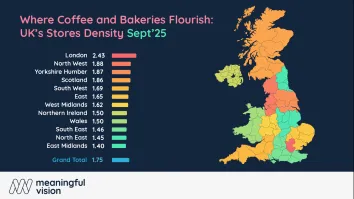QSRs can win big in the tech revolution
Revenue Management Solutions managing director Philipp Laqué details how the sector can take advantage of the latest advances in technology.
(Editor's Note: This article has been lightly edited for clarity.)
The future looks bright for quick service restaurants (QSR). In an industry beset with problems caused by staff shortages, changing consumer tastes and mounting costs, QSRs have an opportunity to rise above it all, leveraging advances in technology.
According to a 2019 report from Global Web Index on findings among consumers in the UK and the US, The Future of Fast Food, 83% of consumers had ordered from a QSR in the past month, while customisation ranked as one of the most important future requirements from the sector. Perhaps QSR is the sector genuinely able to shape the market by scaling up best-in-class tech solutions quickly and on demand, to benefit from the biggest and most lucrative trends we’re seeing today: experience and convenience.
It’s widely known that consumer tastes have changed and continue to do so at a rate unseen in decades thanks to technology. Consumers also want an exceptional experience at the utmost convenience and where better to offer that feeling of progress and the latest trends than in the QSR sector. Indeed, the consumer appetite for fast food sees people coming, in some cases, more than once every day!
A US study has shown more than one in three adults eat fast food on any given day and the BBC reports one in six young people visit a QSR twice a day. These are phenomenal figures and show just how quickly the activities of fast food brands will hit home with the target market. Technology is the driver and, despite creating some potential problems for operators with its lightening speed, tech is also providing solutions – and it’s changing the landscape for good.
Tech-enabled success drivers
One key driver of success for QSR is the scale at which the sector can activate any new-found knowledge. Their enviable footfall and traditionally keen brand followings provide reams of transactional and media-led data points, which feed artificial intelligence and machine learning to power algorithms for new marketing activities. The minute detail also allows for personalised promotions to draw more customers in. QSR’s enormous reach means any digital or technological initiative is activated at such speed and scale, big brands can benefit from success or make changes in almost real-time compared to their smaller rivals.
Automation is just at the start of its journey on to the hospitality scene. QSR operators have been quick to see how they can “de-humanise” low-value, routine tasks, of which this sector has so many, and re-deploy staff on higher-value work. While machines take care of food production – think frying food, dispensing drinks and so on – kitchen staff can be re-trained and re-deployed to service front-of-house and enhance the consumer experience with more hosts to greet guests and extra hands to clear tables or even entertain children. We expect to see this kind of technical assistance become more commonplace over the next couple of years.
Technology is also helping in the challenge to match consumer demand for quality as well as speed. Many QSRs already operate automated order kiosks – McDonalds enjoyed huge success with its touchscreen ordering system and more brands have followed suit. Pret A Manger is trialling a number of digital initiatives, including app-based ordering and drink personalisation, at its Houndsditch site in London.
Wagamama’s trial grab-and-go concept, Mamago, has been designed to capitalise on the increased customer demand for convenience while also meeting the need for a better experience. Here, touchscreens underpin the promise of freshly prepared dishes in under four minutes – a far more realistic goal when digital order-and-pay takes care of the customers so staff are free to produce quality food.
A great number of operators have also upgraded store design to suit décor and design trends, re-introduced table service and put multiple food delivery options in place, from app-based ordering to voice-controlled smart home assistants like Alexa and Google Home. The immediate future will see greater inroads made in mobile and pre-order channels, kerbside delivery and voice-controlled drive-through with automated order pick-up. The next big leap will be an increase in the use of data to create greater personal recognition capabilities and customised products. The Fit is one example, a US-based menu personalisation platform that uses artificial intelligence to give restaurant brands and their customers the option to customise the menu according to their needs.
Give them what they want
With often large-scale chains reaching a huge customer base, QSRs are also able to watch the market and capitalise on trends based on reliable information from their EPoS and consumer data. Unlike smaller brands, the sheer volume of footfall through the doors of the QSR operator mean they are ideally placed to take advantage of the information these myriad customers provide and the transactional power they wield. It’s about being first to call out the so-called “mega trends” and it’s QSRs who can make these giant leaps for the industry as they go.
Think plant vs meat, fresh vs processed and authentic vs generic. Having this kind of intel – often before anyone else – means that, though a QSR operator may specialise in one type of dish – burgers, chicken or salad bowls, for example – it can stay ahead of the curve and create a new experience that will set that brand apart, quickly and first. The new route might take the shape of a food ordering method that promotes the offer, a delivery channel or a change in interior design to reflect the consumer mood of the time. It’s easier to innovate when a brand is confident in the customers’ reaction.
These are just a few examples of how technology can create inroads into the restaurant sector. In my opinion, the fundamental keys to successfully integrating technology are to:
- Understand the consumer pain-points in the current service process
- Develop a technological solution that fits the specific concept and removes the pain-points for consumers (don’t just copy what competitors are doing, they might have a different issue)
- Ensure the technology fits in with the overall brand promise and key value proposition to customers
Does this mean other parts of the industry should look to QSR for the direction the industry is heading at any given time? Why not? When QSR brands up their vegan and vegetarian game or redecorate to reflect that back-to-nature feel, something’s up! There is no doubt consumers dining in all corners of the market, from casual to fine-dining, will be looking for something to reflect the zeitgeist.
Operators outside QSR can turn the tech revolution to their advantage. Casual dining restaurants, for example, could triumph in this area if they wanted to but they’ll succeed differently, deploying tech to distinguish their offer and stay close to consumers in their own way. More about that next time.
























